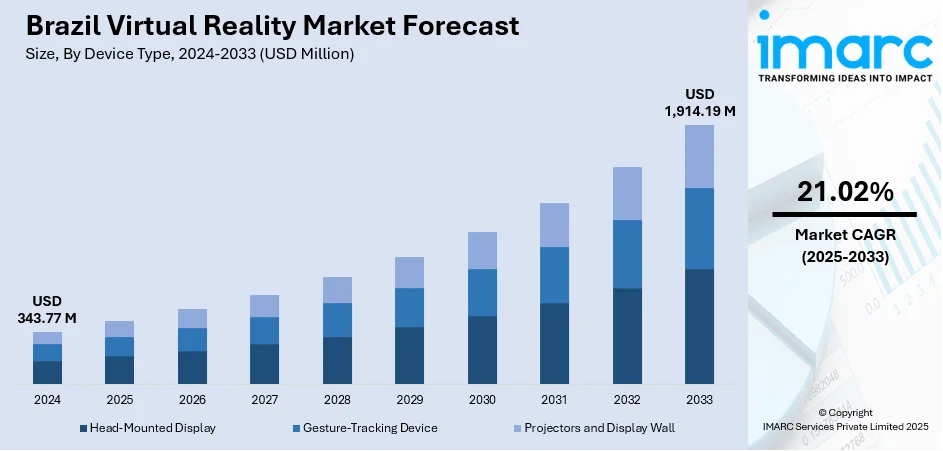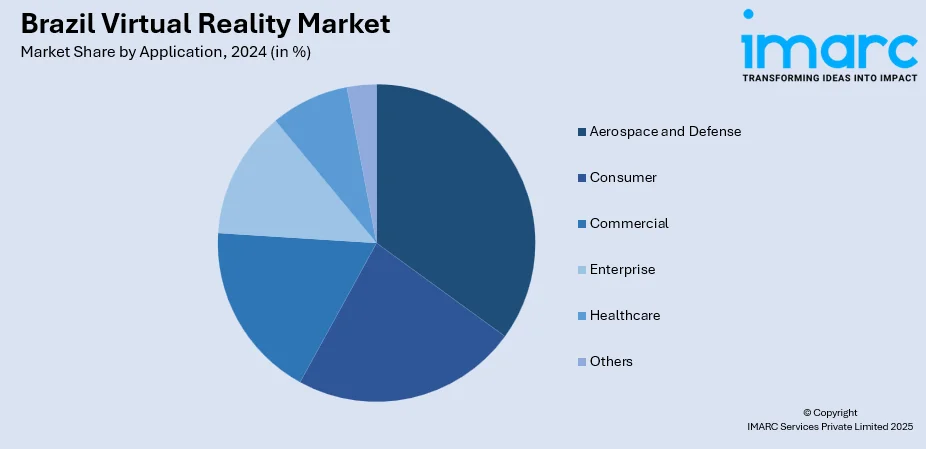
Brazil Virtual Reality Market Size, Share, Trends and Forecast by Device Type, Technology, Component, Application, and Region, 2025-2033
Brazil Virtual Reality Market Overview:
The Brazil virtual reality market size reached USD 343.77 Million in 2024. The market is projected to reach USD 1,914.19 Million by 2033, exhibiting a growth rate (CAGR) of 21.02% during 2025-2033. Tourism boards, travel agencies, and hospitality companies are adopting virtual reality (VR) to showcase destinations, hotels, and experiences in interactive formats that influence booking decisions. Besides this, the broadening of 5G networks, which aids in enhancing connectivity, is contributing to the expansion of the Brazil virtual reality market share.
|
Report Attribute
|
Key Statistics
|
|---|---|
|
Base Year
|
2024 |
|
Forecast Years
|
2025-2033
|
|
Historical Years
|
2019-2024
|
| Market Size in 2024 | USD 343.77 Million |
| Market Forecast in 2033 | USD 1,914.19 Million |
| Market Growth Rate 2025-2033 | 21.02% |
Brazil Virtual Reality Market Trends:
Expansion of 5G networks
The broadening of 5G networks is significantly fueling the market growth in Brazil by enhancing the speed, connectivity, and reliability needed to deliver seamless immersive experiences. According to the official statistics, as of May 2025, about 19.2 Million users were linked to its 5G Standalone network in Brazil. VR requires high bandwidth and low latency for real-time interaction, whether in gaming, education, healthcare, or enterprise applications. With 5G deployment across Brazil, users and businesses can access smoother, lag-free VR experiences, opening opportunities for advanced applications like cloud-based VR gaming, remote training, and immersive virtual meetings. The improved network capabilities allow larger amounts of data to be transferred quickly, supporting higher-resolution VR content and multi-user interactions in real time. For industries, such as healthcare, 5G-enabled VR can transform remote consultations, surgical training, and patient therapy. Similarly, in education, 5G allows students to participate in highly interactive VR classrooms regardless of location. The entertainment and sports sectors also benefit from 5G-powered VR streaming, offering audiences immersive live events. As telecom providers are accelerating 5G rollout across the country, the accessibility and adoption of VR headsets and applications are expected to surge.

To get more information on this market, Request Sample
Increasing tourism activities
Rising tourism activities are impelling the Brazil virtual reality market growth by driving the demand for immersive travel and cultural experiences. Brazil hosted 6.65 Million international tourists in 2024, reflecting a 12.6% increase compared to 2023, as reported by Embratur. This comprised a total of 690,200 international tourists in December alone, equating to an 11.1% rise compared to December 2023. Tourists are seeking unique ways to explore destinations before, during, and after their trips, and VR serves as an ideal tool by providing virtual tours of popular landmarks, historical sites, and cultural attractions. Tourism boards, travel agencies, and hospitality companies are adopting VR to showcase destinations, hotels, and experiences in engaging, interactive formats that influence booking decisions. In Brazil, with its rich cultural heritage, biodiversity, and world-renowned attractions like the Amazon rainforest, Christ the Redeemer, and Iguazu Falls, VR solutions enable global audiences to virtually explore these destinations and encourage tourism inflow. Additionally, VR supports local tourism businesses by offering virtual previews and enhancing marketing strategies. With rising interest in eco-tourism and sustainable travel, VR also provides an environment friendly way to promote destinations while minimizing physical footprint, thereby stimulating broader adoption in Brazil’s tourism sector.
Brazil Virtual Reality Market Segmentation:
IMARC Group provides an analysis of the key trends in each segment of the market, along with forecasts at the country and regional levels for 2025-2033. Our report has categorized the market based on device type, technology, component, and application.
Device Type Insights:
- Head-Mounted Display
- Gesture-Tracking Device
- Projectors and Display Wall
The report has provided a detailed breakup and analysis of the market based on the device type. This includes head-mounted display, gesture-tracking device, and projectors and display wall.
Technology Insights:
- Semi and Fully Immersive
- Non-Immersive
A detailed breakup and analysis of the market based on the technology have also been provided in the report. This includes semi and fully immersive and non-immersive.
Component Insights:
- Hardware
- Software
The report has provided a detailed breakup and analysis of the market based on the component. This includes hardware and software.
Application Insights:

- Aerospace and Defense
- Consumer
- Commercial
- Enterprise
- Healthcare
- Others
A detailed breakup and analysis of the market based on the application have also been provided in the report. This includes aerospace and defense, consumer, commercial, enterprise, healthcare, and others.
Regional Insights:
- Southeast
- South
- Northeast
- North
- Central-West
The report has also provided a comprehensive analysis of all the major regional markets, which include Southeast, South, Northeast, North, and Central-West.
Competitive Landscape:
The market research report has also provided a comprehensive analysis of the competitive landscape. Competitive analysis such as market structure, key player positioning, top winning strategies, competitive dashboard, and company evaluation quadrant has been covered in the report. Also, detailed profiles of all major companies have been provided.
Brazil Virtual Reality Market News:
- In May 2024, the Alstom Foundation, in collaboration with the Instituto Jô Clemente (IJC), revealed the initiation of the ‘Virtual Reality for Inclusion’ project in Brazil. This initiative leveraged VR to recreate real-world scenarios, assisting individuals with disabilities, such as those with Rare Diseases and Autism Spectrum Disorder (ASD), in acquiring skills to maneuver through a world that was not tailored to their needs.
Brazil Virtual Reality Market Report Coverage:
| Report Features | Details |
|---|---|
| Base Year of the Analysis | 2024 |
| Historical Period | 2019-2024 |
| Forecast Period | 2025-2033 |
| Units | Million USD |
| Scope of the Report | Exploration of Historical Trends and Market Outlook, Industry Catalysts and Challenges, Segment-Wise Historical and Future Market Assessment:
|
| Device Types Covered | Head-Mounted Display, Gesture-Tracking Device, Projectors and Display Wall |
| Technologies Covered | Semi and Fully Immersive, Non-Immersive |
| Components Covered | Hardware, Software |
| Applications Covered | Aerospace and Defense, Consumer, Commercial, Enterprise, Healthcare, Others |
| Regions Covered | Southeast, South, Northeast, North, Central-West |
| Customization Scope | 10% Free Customization |
| Post-Sale Analyst Support | 10-12 Weeks |
| Delivery Format | PDF and Excel through Email (We can also provide the editable version of the report in PPT/Word format on special request) |
Key Questions Answered in This Report:
- How has the Brazil virtual reality market performed so far and how will it perform in the coming years?
- What is the breakup of the Brazil virtual reality market on the basis of device type?
- What is the breakup of the Brazil virtual reality market on the basis of technology?
- What is the breakup of the Brazil virtual reality market on the basis of component?
- What is the breakup of the Brazil virtual reality market on the basis of application?
- What is the breakup of the Brazil virtual reality market on the basis of region?
- What are the various stages in the value chain of the Brazil virtual reality market?
- What are the key driving factors and challenges in the Brazil virtual reality market?
- What is the structure of the Brazil virtual reality market and who are the key players?
- What is the degree of competition in the Brazil virtual reality market?
Key Benefits for Stakeholders:
- IMARC’s industry report offers a comprehensive quantitative analysis of various market segments, historical and current market trends, market forecasts, and dynamics of the Brazil virtual reality market from 2019-2033.
- The research report provides the latest information on the market drivers, challenges, and opportunities in the Brazil virtual reality market.
- Porter's five forces analysis assist stakeholders in assessing the impact of new entrants, competitive rivalry, supplier power, buyer power, and the threat of substitution. It helps stakeholders to analyze the level of competition within the Brazil virtual reality industry and its attractiveness.
- Competitive landscape allows stakeholders to understand their competitive environment and provides an insight into the current positions of key players in the market.
Need more help?
- Speak to our experienced analysts for insights on the current market scenarios.
- Include additional segments and countries to customize the report as per your requirement.
- Gain an unparalleled competitive advantage in your domain by understanding how to utilize the report and positively impacting your operations and revenue.
- For further assistance, please connect with our analysts.
 Request Customization
Request Customization
 Speak to an Analyst
Speak to an Analyst
 Request Brochure
Request Brochure
 Inquire Before Buying
Inquire Before Buying




.webp)




.webp)












